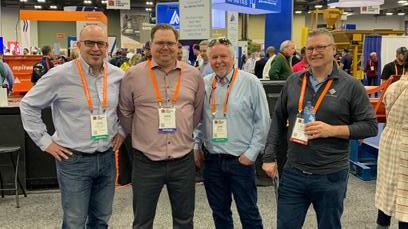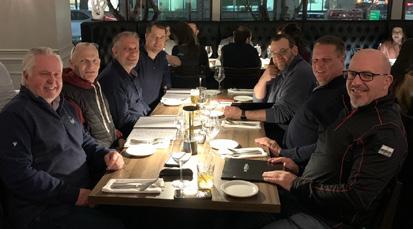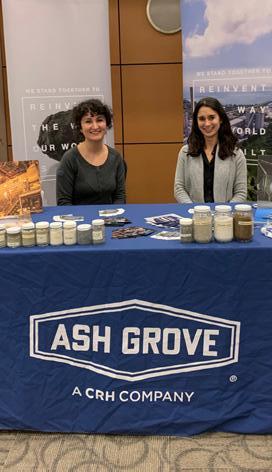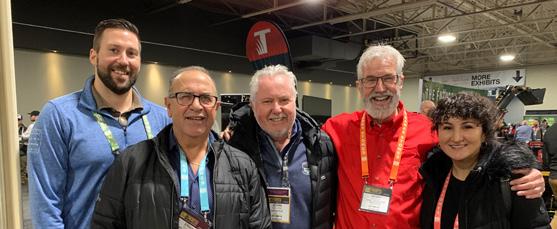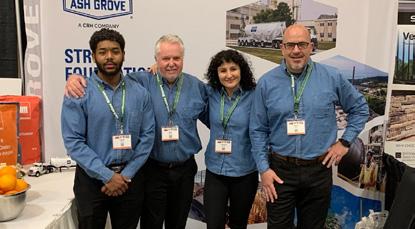DISPATCH



I hope you are keeping safe and well. In February, we wrapped up our annual Ash Grove Conference in San Diego and I wanted to take an opportunity to write to you about what we discussed and the priorities for Ash Grove in 2023.
It’s an exciting time for Ash Grove as we continue to grow and adapt, always remaining motivated, responsive and customer-connected. Our organization is transforming the opportunities of a changing world into successes for Ash Grove. The cement industry is an exciting area to work in and develop. We’ll continue to meet and bring inspired people together in forums like this to ensure Ash Grove strengthens our industry leadership position in North America.
Recently, we announced organizational changes that will ensure that we continue to be well-positioned for focused growth, capitalize on sustainable solutions, drive innovation and consolidate our regions, while providing opportunities for greater performance.
While in San Diego, our East and West Regions, Sapphire Americas and our Strategy
and Business Solution function discussed making our products more straightforward, safer and more sustainable for our customers.
Finally, we highlighted how Solutions will affect our business and your needs. We heard from leaders of other CRH-operating companies and our customers on “What do Solutions mean to you?” We will take these discussions and build upon them in 2023. At Ash Grove, we are a vital part of the communities where we are located and we aim to provide solutions to meet the climate change challenges ahead of us. From net-zero strategies to utilizing new energies with the addition of our Sapphire Americas division – we are helping the world and our customers shape the future of this planet.
I am excited about the path ahead for Ash Grove, which is full of opportunity, now and for years to come. Our teams are delivering on our purpose of shaping a sustainable future every day through the services we provide to our customers and how we operate our business.
Thank you for your continued partnership with Ash Grove and our mutual success.
Serge Schmidt Ash Grove President

Daniel Salvo has recently joined the Ontario Sales team as their new market manager. He previously worked at EXACT Technology Corporation as a technical sales professional. Daniel has an extensive background in the concrete industry, starting as a summer quality control technician with Dufferin Concrete in 2007 while completing his chemical engineering degree at the University of Toronto (BAsc). After graduation, he worked as a project coordinator at Euclid Admixture Canada Inc. before moving on to EXACT Technology Corp. His wealth of knowledge and experience in the field make him a valuable addition to the team.
We are excited to announce organizational changes within Ash Grove to ensure that we continue to be well-positioned for growth, capitalize on sustainable solutions, drive innovation, and consolidate our regions, providing opportunities for greater efficiencies.
The East Region will now consist of the current alignment plus the addition of Houston Cement Company (HCC), the Midlothian, and Foreman plants and related markets. Monica Manolas, who has been with Ash Grove for over 25 years, will oversee the East Region as President. Our Ontario, Manitoba, Saskatchewan, Quebec & Atlantic and Great Lakes region will continue to be a part of this newly-formed East Region. With this change, we also welcome
Hal Boudreau, who will be responsible for commercial oversight in the East Region, including Commercial Excellence, Customer Experience, and Sales and Marketing activities in the region.
The West Region will now consist of the current alignment plus the addition of the Louisville and Chanute plants and related markets, along with Alberta and the Duluth import terminal. Brian Rhees, who has been with Ash Grove for over

30 years, will oversee the West Region as President.
We believe these changes will enable us to capitalize on growth opportunities, provide greater efficiencies and drive innovation in sustainability and sustainable solutions. As always, we remain committed to providing our customers with the highest level of service and quality products.
Over the last few years, we have acquired a keen understanding of the ever-changing landscape of the industry, society, and the world at large – from the honed focus on climate to the constant changes in technology.
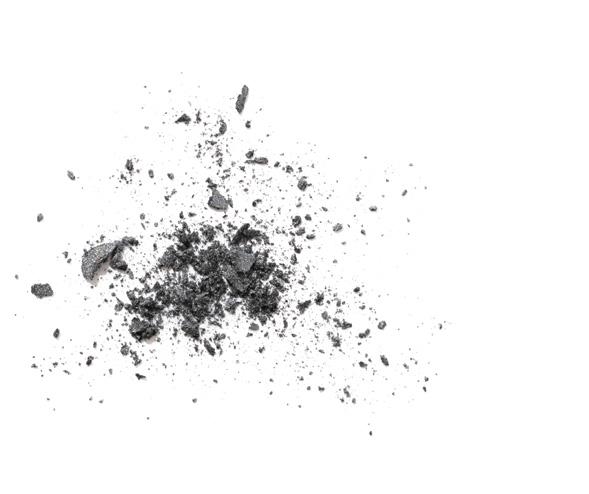



With our relentless drive, we take a stand for our future generations, a stand of inclusion and diversity, and a stand for sustainability. We rethink, reimagine, and reinvent solutions for the built environment. Making homes, buildings, and infrastructure that stand the test of time.
To ensure that CRH continues to adapt and thrive, we have ascertained and articulated CRH’s Purpose to help guide and shape the “CRH of the future.” CRH’s Purpose was launched at the annual leadership conference in May 2022.
Our Purpose is at the intersection of what the world needs and how we satisfy that need. Purpose answers what it means to be “A CRH Company” and what we stand together for.
Because no matter where you stand, We Stand Together to Reinvent the Way our World is Built.



WHERE WE ARE GOING to develop sustainable solutions that built, connect and improve our World


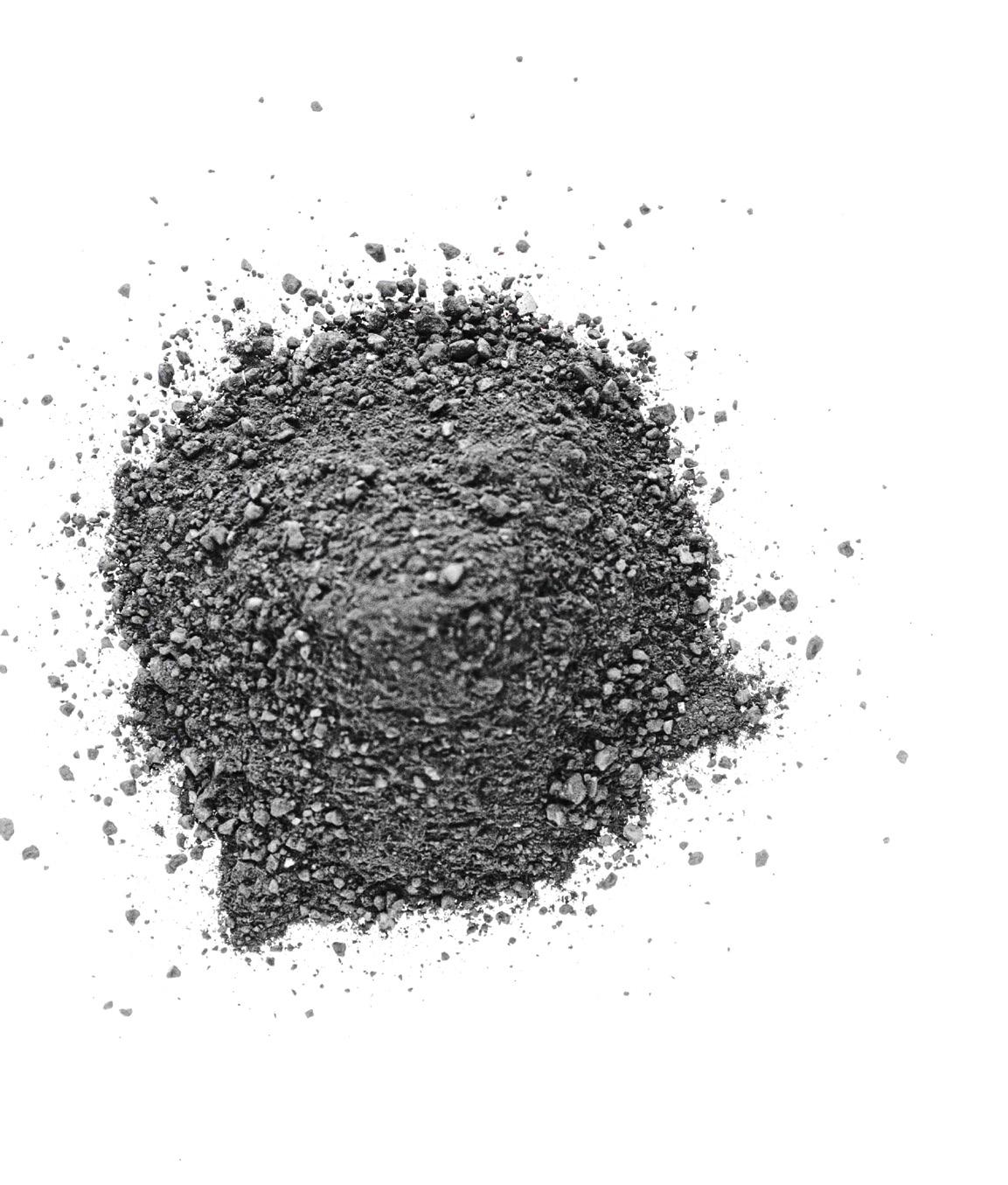

We’re thrilled to announce that CRH Ventures has invested in Carbon Upcycling Technologies, a company witch shares our circular, zero-waste sustainability values. Their ground-breaking technology transforms local industrial by-products or
natural materials into superior cementitious materials, significantly reducing clinker content and CO2 emissions. This means cement and readymix concrete manufacturers can now produce more sustainable products with less embodied carbon. This

partnership with Ash Grove, a CRH company, will also help to launch Carbon Upcycling’s first industrial-size facility at Ash Grove’s Mississauga, Ontario, Canada cement plant. We’re excited to scale Carbon Upcycling’s technology across our operations and to
provide them access to our 50-plus years of expertise. Together, we’re driving significant progress in the decarbonization of the cement industry, and we can’t wait to bring this innovative and sustainable solution to the broader market.
The Cement Association of Canada (CAC) will soon release the updated version of its Portland Limestone Cement (PLC) Technical Summary Report. This report was created to help educate the concrete industry on the use of PLC, more formerly known as GUL or IL. The CAC has been a tremendous help in advocating the use and advantages of GUL across Canada and Ontario has been at the forefront of the use of GUL in structures and pavements over the last 15 years. As you are aware, the cement and concrete industry has pledged to be net-zero carbon by 2050. This goal will involve a lot of work, but the use of GUL is a big first step. GUL, as you know, has approximately 10% more inter-ground limestone than its GU counterpart. With with high supplementary cementitious materials (SCMs), GUL can help drive down the carbon footprint of ready-mixed
concrete while maintaining equivalent performance to traditional GU mixes.
The original PLC technical document was released in May of 2021 to show its equivalence to Portland Cement (PC) or GU. The document touches on workability, set-time, strength (1-28 days), freeze-thaw, scaling, resistance to chloride penetration (RCP), alkali-silica reactivity, shrinkage, and sulfate resistance. It demonstrates the use and acceptance of GUL across Canada (see map below). More importantly, it explains its advantage to reducing the carbon footprint of concrete and how that can compound with higher SCM usages (see table below for example).
We can expect the update to include:
• Further studies on the use of GUL with reactive aggregates and its ability to remain under the CSA limits as with GU with the assistance of SCMs
• Additional studies on shrinkage and creep with GUL shows comparable trends to GU
• An updated list on GUL approval across Canada
• An update on central and western Canada getting GUL approved for the use in structural and precast concrete
• Continued work by the CAC with local municipalities and concrete associations across Canada to help promote and drive the use of GUL in our structures and pavements
What’s next? Ash Grove is committed to producing low global warming potential (GWP) products and is currently working on GULs with limestone percentages as high as 25% and High-Early (HE) cements with inter-ground limestone as high as 15%.

Help Tech Team!












































We are trying to bid on a federal project that is budgeted at or above $10 million, using a minimum 100 m3 of ready mixed concrete. The project requirements are for us to meet 10% reduction from the total project GHG emissions from ready mixed concrete. This entire concept is fairly new to our industry and we are seeking help! Do you have any recommendations or guideline’s for Specifying Low Carbon Concrete?





Sincerely, Wreck-it Ralph Ready-Mix




Concrete is one of the most common construction materials in the world and the second most consumed material on the planet after water. As we move forward and attempt to decarbonize as rapidly as possible over the next decade, we must make sure we’re looking at







construction and development and, complex shapes and configurations by adjusting its mix. It is long-lasting, dependable and can consume recycled waste without compromising quality.



As we all lead the path together and join forces on this journey to roadmap net-zero, we’re pleased to share that there are Lower Carbon Concrete Levers already available today. Many industrial wastes can be recycled as a substitute for cement or aggregate, including fly ash, slag, or GGBFS or ground granulated blast-furnaces slag. The Ready-Mix Concrete Association of Ontario has helped to provide methods for lowering the carbon footprint in concrete. Knowing that we can answer the often-asked question, “What can I do right now to reduce the carbon intensity of my concrete?”
If you want the best in concrete technology with the lowest available carbon footprint working for you ~ following CSA’s Performance-Based Specifications approach is critical. This is key to low carbon development, and therefore we can ONLY get both PERFORMANCE and LOW CARBON ADVANCEMENT via PERFORMANCEBASED SPECIFICATIONS. We need to step away from “age-old” prescriptive concrete specifications which do nothing but limit performance and advancement.
How to drive this critical change?
Indicate the long-term hardened properties and the short-term construction properties needed for placing & finishing by specifying:
• The performance property required
• The test method for evaluation
• And the minimum and/or maximum allowable acceptance value
Specifications need to indicate to all parties that carbon reduction is a critical design factor & project goal. The concrete industry is advancing in this regard ~ with more EPDs than any other building material!
What can be done at a project level?
When all parties are clear on project start times, construction methods, external weather demands, and performance needs like early strength development, set a Pre-Construction meeting to discuss carbon reduction optimization and how it can benefit both the project, the community, and our environment.
t h e t e c h t e a m
Did you know that bad concrete testing practices can lead to significantly over-designed concrete mixes on your projects? That’s right, bad cylinder practices cause cylinders to break lower than actual strength. The biggest culprit is often incorrect site cylinder storage practices. When poor concrete testing practices NOT in line with CSA standards are tolerated on a job site, concrete producers often have no choice but to over-design their concrete mixes to achieve desired strength.
Do your specs consider the use of:
• The latest in admixture technology
• Innovative lower-carbon materials
• Innovative carbon technologies
• In-situ performance monitoring solutions
3. ALLOW LOW
RAW
Outdated Prescriptive Specifications are inadvertently increasing the carbon intensity of concrete. Ensure your specifications are updated to current versions of CSA, using Performance Based standards and allowing the use of a full suite of CSA-approved lower carbon raw materials. Taking these actions will immediately unlock notable carbon savings while meeting your performance needs. For more than a decade, the cement industry has been producing Portland Limestone Cement (CSA Type GUL) as a replacement to General Use (CSA Type GU) cement. While this material has the same performance properties as GU cement, its carbon intensity is 10% lower!


“As an EMBA student with Ivey Business School, I recently went on a week-long Discovery Expedition trip to Vietnam. It was an incredible experience, from exploring Ho Chi Minh City by Vespa to boating along the Mekong Delta. Ivey’s EMBA program offered me and my classmates the rare opportunity to immerse ourselves in the cultural, political, and economic realities of one of the world’s economic hot spots.
We started our trip with an introduction to the history and culture of Vietnam. We took a Vespa tour around Ho Chi Minh City, explored Saigon on bikes, and, in smaller groups, went on to discover various parts of the city to experience the rich Vietnamese culture. It was fascinating to learn about how different businesses run from country to country and how cultural differences affect the way they approach business.
One of our tasks on the trip was to choose either a Canadian or Vietnamese company that could be integrated into the other country’s economy. My team was working on how a Canadian company should expand into the beloved Vietnamese karaoke culture and were required to set up meetings throughout the week to conduct research on our chosen project. This opportunity proved to me that there is always a new business or opportunity to discover, even on the other side of the world.
Throughout the week, we attended several meetings that had been set up to help us better understand the culture, economy, business landscape, and social environment within Vietnam. Students had the opportunity to make in-person visits to several companies, including Heineken Vietnam, Tessellation, Michelin, TetraPak, Logistik Unicorp, Thien Phuoc Centre, tech startup Futurify, Everest Education,
St. John’s Packaging, and Saigon Children, a not-for-profit organization educating disadvantaged Vietnamese children.
The trip allowed me to distill clarity concerning my role as a leader and how to consider cross-cultural differences when conducting critical conversations and establishing what’s important in various cultures. I also left the experience with a newfound appreciation for resilience, recognizing the resilient nature of the Vietnamese people. Resilience is crucial in one’s career, and I’m grateful for the opportunity to learn from the Vietnamese people.
Overall, the trip to Vietnam was an amazing experience. From the friendships and memories built with my Ivey family to the new business insights, I will always remember this trip as one of the highlights of my EMBA program.”
 - Emma Schindler
- Emma Schindler
To continue our leadership and commitment to safety, the tech services team will start conducting safety audits on our cement trucks and drivers. We take the safety and safety practices of our drivers at the cement plant very seriously and we should at your (our customers) plant sites as well. This exercise will help us identify where we can improve, but to also highlight and acknowledge those drivers that are going above and beyond to ensure their safety and yours.
This inspection sheet will focus on:
1. Site Access: Mobility, and accessibility for the driver
2. Equipment: Equipment in proper working order and the driver monitoring gages
3. Personal Protective Equipment (PPE): Ensure all PPE is being used correctly
4. Connections: Ensure they are secured and all gaskets and camlocks are in good condition
5. Customer site best practices: No personal phones, caps are locked and properly identified
What’s next? Audits on ready mix truck drivers. Quite often we are out at your plant testing and frequently interact with your ready-mix drivers. Our goal is to provide an outsider’s perspective as day-to-day risks can sometimes be overlooked.

